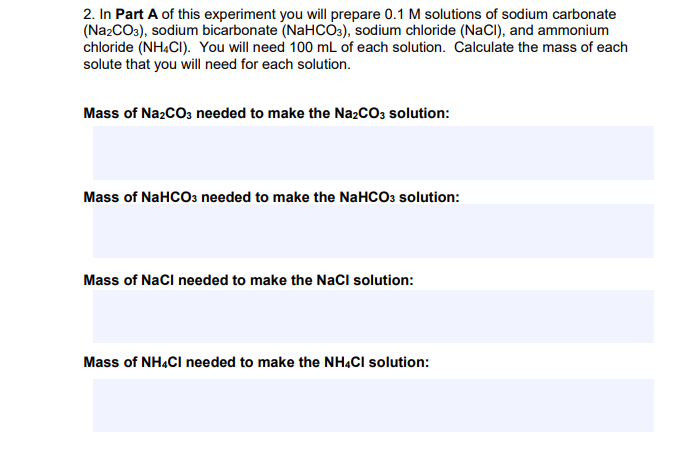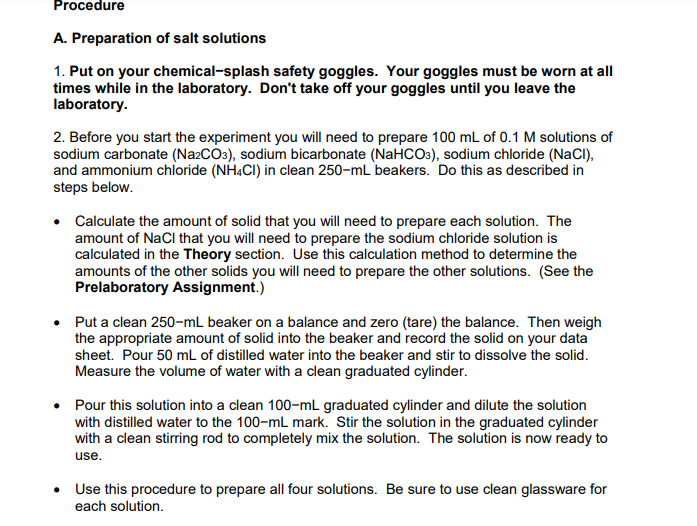2. In Part A of this experiment you will prepare 0.1 M solutions of sodium carbonate (NazCO3), sodium bicarbonate (NaHCcỏa), sodium chloride (NaCI), and ammonium chloride (NH.CI). You will need 100 mL of each solution. Calculate the mass of each solute that you will need for each solution. Mass of NazCO3 needed to make the NazCO3 solution: Mass of NaHCOs needed to make the NaHCOs solution: Mass of Nacl needed to make the NaCl solution: Mass of NH,CI needed to make the NH.CI solution:
2. In Part A of this experiment you will prepare 0.1 M solutions of sodium carbonate (NazCO3), sodium bicarbonate (NaHCcỏa), sodium chloride (NaCI), and ammonium chloride (NH.CI). You will need 100 mL of each solution. Calculate the mass of each solute that you will need for each solution. Mass of NazCO3 needed to make the NazCO3 solution: Mass of NaHCOs needed to make the NaHCOs solution: Mass of Nacl needed to make the NaCl solution: Mass of NH,CI needed to make the NH.CI solution:
Introductory Chemistry: A Foundation
9th Edition
ISBN:9781337399425
Author:Steven S. Zumdahl, Donald J. DeCoste
Publisher:Steven S. Zumdahl, Donald J. DeCoste
Chapter15: Solutions
Section: Chapter Questions
Problem 94AP: 94. Baking soda (sodium hydrogen carbonate. NaHCO3) is often used to neutralize spills of acids on...
Related questions
Question

Transcribed Image Text:2. In Part A of this experiment you will prepare 0.1 M solutions of sodium carbonate
(NazCO3), sodium bicarbonate (NaHCO3), sodium chloride (NaCl), and ammonium
chloride (NH.CI). You will need 100 mL of each solution. Calculate the mass of each
solute that you will need for each solution.
Mass of NazCO; needed to make the NazCO; solution:
Mass of NaHCO3 needed to make the NaHCO3 solution:
Mass of Nacl needed to make the Nacl solution:
Mass of NH.Cl needed to make the NH,CI solution:

Transcribed Image Text:Procedure
A. Preparation of salt solutions
1. Put on your chemical-splash safety goggles. Your goggles must be worn at all
times while in the laboratory. Don't take off your goggles until you leave the
laboratory.
2. Before you start the experiment you will need to prepare 100 mL of 0.1 M solutions of
sodium carbonate (Na2CO3), sodium bicarbonate (NaHCO3), sodium chloride (NaCI),
and ammonium chloride (NH.CI) in clean 250-mL beakers. Do this as described in
steps below.
• Calculate the amount of solid that you will need to prepare each solution. The
amount of NaCl that you will need to prepare the sodium chloride solution is
calculated in the Theory section. Use this calculation method to determine the
amounts of the other solids you will need to prepare the other solutions. (See the
Prelaboratory Assignment.)
• Put a clean 250-mL beaker on a balance and zero (tare) the balance. Then weigh
the appropriate amount of solid into the beaker and record the solid on your data
sheet. Pour 50 mL of distilled water into the beaker and stir to dissolve the solid.
Measure the volume of water with a clean graduated cylinder.
Pour this solution into a clean 100-mL graduated cylinder and dilute the solution
with distilled water to the 100-mL mark. Stir the solution in the graduated cylinder
with a clean stirring rod to completely mix the solution. The solution is now ready to
use.
• Use this procedure to prepare all four solutions. Be sure to use clean glassware for
each solution.
Expert Solution
This question has been solved!
Explore an expertly crafted, step-by-step solution for a thorough understanding of key concepts.
This is a popular solution!
Trending now
This is a popular solution!
Step by step
Solved in 2 steps with 2 images

Knowledge Booster
Learn more about
Need a deep-dive on the concept behind this application? Look no further. Learn more about this topic, chemistry and related others by exploring similar questions and additional content below.Recommended textbooks for you

Introductory Chemistry: A Foundation
Chemistry
ISBN:
9781337399425
Author:
Steven S. Zumdahl, Donald J. DeCoste
Publisher:
Cengage Learning

Chemistry
Chemistry
ISBN:
9781305957404
Author:
Steven S. Zumdahl, Susan A. Zumdahl, Donald J. DeCoste
Publisher:
Cengage Learning


Introductory Chemistry: A Foundation
Chemistry
ISBN:
9781337399425
Author:
Steven S. Zumdahl, Donald J. DeCoste
Publisher:
Cengage Learning

Chemistry
Chemistry
ISBN:
9781305957404
Author:
Steven S. Zumdahl, Susan A. Zumdahl, Donald J. DeCoste
Publisher:
Cengage Learning


Chemistry: An Atoms First Approach
Chemistry
ISBN:
9781305079243
Author:
Steven S. Zumdahl, Susan A. Zumdahl
Publisher:
Cengage Learning

Chemistry: The Molecular Science
Chemistry
ISBN:
9781285199047
Author:
John W. Moore, Conrad L. Stanitski
Publisher:
Cengage Learning

Introductory Chemistry: An Active Learning Approa…
Chemistry
ISBN:
9781305079250
Author:
Mark S. Cracolice, Ed Peters
Publisher:
Cengage Learning